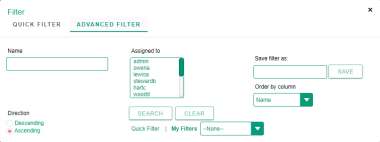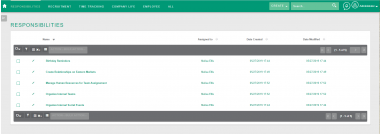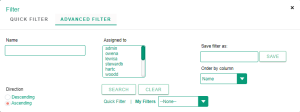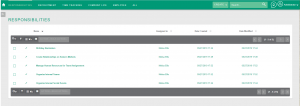Difference between revisions of "Module:Responsibilities"
| Line 11: | Line 11: | ||
|Module-hidden=No | |Module-hidden=No | ||
|Related Screens=File:MintHCM - Responsibilities - List View.png,File:MintHCM - Responsibilities - Record View.png, File:MintHCM - Responsibilities - Filters.png | |Related Screens=File:MintHCM - Responsibilities - List View.png,File:MintHCM - Responsibilities - Record View.png, File:MintHCM - Responsibilities - Filters.png | ||
| − | |Short Description=The | + | |Short Description=The "Responsibilities" module helps manage tasks and allows users to define, assign and perform in the organization. This module is integrated with key modules like Positions, Roles, Appraisal Items, and Activities. |
}} | }} | ||
| Line 18: | Line 18: | ||
==== Overview ==== | ==== Overview ==== | ||
| − | The 'Responsibilities' | + | The 'Responsibilities' tool helps us manage tasks effectively in our system. You can set, assign, and keep track of tasks, making sure everyone is responsible. It has fields like Name, Assigned to, and Description, giving a clear place to describe each task. Connected with 'Positions' and 'Roles,' it links tasks to our team structure, making it clear who does what. The tool also helps in performance reviews with 'Appraisal Items,' making it easy to evaluate how well tasks are done. Linked to the 'Activities' tool, it ensures tasks match our big goals. With an easy-to-use interface, it helps us see what's happening in real-time, making our work transparent and responsive. |
==== Fields ==== | ==== Fields ==== | ||
| Line 48: | Line 48: | ||
* [[Module:AppraisalItems|Appraisal Items]] | * [[Module:AppraisalItems|Appraisal Items]] | ||
| − | Responsibilities | + | Responsibilities in our organization are closely tied to specific positions, and the module easily works with the 'Positions' tool. This means we can perfectly match tasks with where they fit in the organizational structure, making everything clear and efficient. |
| − | + | Also, we can link responsibilities to specific roles using the 'Roles' module. This way, people in certain roles know exactly what tasks they need to handle. | |
| − | + | Our 'Responsibilities' module is a big help in performance reviews because it connects with 'Appraisal Items.' This link makes it easy to evaluate how well someone is doing their assigned tasks, giving an extra layer to our review process. | |
| − | In | + | In our day-to-day work and ongoing projects, the module smoothly connects with the 'Activities' tool. This connection ensures that our tasks directly contribute to our bigger organizational goals, creating a work environment that's well-coordinated and goal-focused. |
==== Role in the Hiring Process ==== | ==== Role in the Hiring Process ==== | ||
| − | The 'Responsibilities' module | + | The 'Responsibilities' module in the hiring process by providing a structured framework for defining and assigning roles and tasks related to recruitment. Within this module, administrators can clearly outline the responsibilities associated with each stage of the hiring process, from creating job descriptions to conducting interviews and evaluating candidates. |
Administrators utilize the 'Responsibilities' module to assign specific tasks to individuals or teams involved in the hiring process. This ensures that everyone is aware of their role and responsibilities, fostering collaboration and efficiency. For example, responsibilities may include crafting compelling job descriptions, conducting initial candidate screenings, or coordinating interview schedules. | Administrators utilize the 'Responsibilities' module to assign specific tasks to individuals or teams involved in the hiring process. This ensures that everyone is aware of their role and responsibilities, fostering collaboration and efficiency. For example, responsibilities may include crafting compelling job descriptions, conducting initial candidate screenings, or coordinating interview schedules. | ||
| − | + | This module facilitates accountability during recruitment. By clearly defining responsibilities and assigning them within the system, administrators can easily track the progress of each task. This transparency enhances communication among team members and ensures that steps in the hiring process are completed in a timely manner. | |
Additionally, the 'Responsibilities' module integrates seamlessly with other hiring-related modules, such as 'Positions' and 'Roles.' This integration allows for the alignment of responsibilities with specific job positions and organizational roles, ensuring that tasks are tailored to the unique requirements of each hiring scenario. | Additionally, the 'Responsibilities' module integrates seamlessly with other hiring-related modules, such as 'Positions' and 'Roles.' This integration allows for the alignment of responsibilities with specific job positions and organizational roles, ensuring that tasks are tailored to the unique requirements of each hiring scenario. | ||
Latest revision as of 09:33, 11 December 2023
| Responsibilities | |
|---|---|
| Name: | Responsibilities |
| Tech Name: | Responsibilities |
| Class Name: | Responsibilities |
| Type: | Standard |
| Template: | Security_groups, Assignable, Basic |
| Custom Module: | No |
| Auditable: | Yes |
| Importable: | No |
| Reportable: | Yes |
| Hide module on Main Page: | No |
Contents
Short Description
The "Responsibilities" module helps manage tasks and allows users to define, assign and perform in the organization. This module is integrated with key modules like Positions, Roles, Appraisal Items, and Activities.
Business Description
Overview
The 'Responsibilities' tool helps us manage tasks effectively in our system. You can set, assign, and keep track of tasks, making sure everyone is responsible. It has fields like Name, Assigned to, and Description, giving a clear place to describe each task. Connected with 'Positions' and 'Roles,' it links tasks to our team structure, making it clear who does what. The tool also helps in performance reviews with 'Appraisal Items,' making it easy to evaluate how well tasks are done. Linked to the 'Activities' tool, it ensures tasks match our big goals. With an easy-to-use interface, it helps us see what's happening in real-time, making our work transparent and responsive.
Fields
The Responsibilities module is comprised of multiple fields, each meticulously crafted with a distinct purpose in mind, serving to capture and organize essential responsibilities-related information. Here is a detailed explanation of each field:
| Name | The concise title or description of the responsibility. | |
| Description | The detailed content outlining the specific tasks and obligations associated with the responsibility. | |
| Assigned User | The user designated to manage or handle the assigned responsibility. | |
| Date Created | The date and time when the responsibility was initially created. | |
| Date Modified | The date and time when the responsibility was last edited or modified. |
Note: Fields marked with an asterisk are required. Saving the record without providing input to them beforehand won't be possible.
Relations
The 'Responsibilities' module is intricately connected with several key modules, amplifying its utility across various aspects of organizational management. These related modules include:
Responsibilities in our organization are closely tied to specific positions, and the module easily works with the 'Positions' tool. This means we can perfectly match tasks with where they fit in the organizational structure, making everything clear and efficient.
Also, we can link responsibilities to specific roles using the 'Roles' module. This way, people in certain roles know exactly what tasks they need to handle.
Our 'Responsibilities' module is a big help in performance reviews because it connects with 'Appraisal Items.' This link makes it easy to evaluate how well someone is doing their assigned tasks, giving an extra layer to our review process.
In our day-to-day work and ongoing projects, the module smoothly connects with the 'Activities' tool. This connection ensures that our tasks directly contribute to our bigger organizational goals, creating a work environment that's well-coordinated and goal-focused.
Role in the Hiring Process
The 'Responsibilities' module in the hiring process by providing a structured framework for defining and assigning roles and tasks related to recruitment. Within this module, administrators can clearly outline the responsibilities associated with each stage of the hiring process, from creating job descriptions to conducting interviews and evaluating candidates.
Administrators utilize the 'Responsibilities' module to assign specific tasks to individuals or teams involved in the hiring process. This ensures that everyone is aware of their role and responsibilities, fostering collaboration and efficiency. For example, responsibilities may include crafting compelling job descriptions, conducting initial candidate screenings, or coordinating interview schedules.
This module facilitates accountability during recruitment. By clearly defining responsibilities and assigning them within the system, administrators can easily track the progress of each task. This transparency enhances communication among team members and ensures that steps in the hiring process are completed in a timely manner.
Additionally, the 'Responsibilities' module integrates seamlessly with other hiring-related modules, such as 'Positions' and 'Roles.' This integration allows for the alignment of responsibilities with specific job positions and organizational roles, ensuring that tasks are tailored to the unique requirements of each hiring scenario.
Custom Actions
Processes
Related Processes
| Process | Short Description |
|---|---|
| Job Description | The description of the functionalities associated with workplace |
Related Process Steps
Related Features
Affected by
Initiating
Related Integrations
Structure
Fields
| Name | Type | Required | Validations | Visible | Editable |
|---|---|---|---|---|---|
| Assigned to | relate | No | Yes | Yes | |
| Created by | relate | No | Yes | No | |
| Date Created | datetime | No | Yes | No | |
| Date Modified | datetime | No | Yes | No | |
| Description | text | No | Yes | Yes | |
| Modified by Name | relate | No | Yes | No | |
| Name | name | Yes | Yes | Yes |
Relationships
| Laft | Type | Right | Short Description | Relationship |
|---|---|---|---|---|
| Responsibilities | one-to-many | Appraisal Items | Flex relate used in Responsibilities | Relationship: Responsibilities - AppraisalItems |
| Users | one-to-many | Responsibilities | Specific Sugar user can modify many account records, but specific account record last modification was performed by specific user. | Relationship: Users - Responsibilities |
| Users | one-to-many | Responsibilities | Specific Sugar user can create many account records, but specific account record can be created by only one user. | Relationship: Users - Responsibilities |
| Users | one-to-many | Responsibilities | Specific Sugar user can be assigned to many account records, but specific account record can only have one user assigned. | Relationship: Users - Responsibilities |





